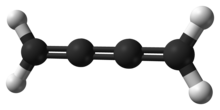Cumulene

Acumuleneis a compound having three or morecumulative(consecutive)double bonds.[1]They are analogous toallenes,only having a more extensive chain. The simplest molecule in this class isbutatriene(H2C=C=C=CH2), which is also called simplycumulene.Unlike mostalkanesandalkenes,cumulenes tend to be rigid, comparable topolyynes.Cumulene carbenesH2Cnfornfrom 3 to 6 have been observed in interstellarmolecular clouds[2][3]and in laboratory experiments[4]by using microwave and infrared spectroscopy. (The more stable cumulenesH2CnH2are difficult to detect optically because they lack an electric dipole moment.) Cumulenes containingheteroatomsare calledheterocumulenes;[5]an example iscarbon suboxide.
Synthesis
[edit]The first reported synthesis of a butatriene is that of tetraphenylbutatriene in 1921.[6]The most common synthetic method for butatriene synthesis is based onreductive couplingof ageminaldihalovinylidene.[7]Tetraphenylbutatriene was reported synthesized in 1977 by homocoupling of 2,2-diphenyl-1,1,1-tribromoethane with elementalcopperindimethylformamide.[8]
Structure
[edit]
The rigidity of cumulenes arises from the fact that the internal carbon atoms carry double bonds. Their sp hybridisation results in twoπ bonds,one to each neighbor, which are perpendicular to each other. This bonding reinforces alinear geometryof the carbon chain.
Cumulenes with non-equivalent substituents on each end exhibitisomerism.If the number of consecutive double bonds is odd, there iscis–transisomerismas for alkenes. If the number of consecutive double bonds is even, there isaxial chiralityas for allenes.
Transition metal cumulenes
[edit]The first reportedcomplexcontaining a vinylidene ligand was (Ph2C2Fe2(CO)8,derived from the reaction ofdiphenylketeneandFe(CO)5.Structurally, this molecule resemblesFe2(CO)9,wherein oneμ-CO ligand is replaced by 1,1-diphenylvinylidene, Ph2C2.The first monometallic vinylidene complex was (C5H5)Mo(P(C6H5)3)(CO)2[C=C(CN)2]Cl.[9]
See also
[edit]- Cyclopropatrieneandcyclohexahexaene,cyclic cumulenes
References
[edit]- ^IUPAC,Compendium of Chemical Terminology,2nd ed. (the "Gold Book" ) (1997). Online corrected version: (2006–) "cumulenes".doi:10.1351/goldbook.C01440
- ^Thaddeus, P.; Gottlieb, C.A.; Mollaaghababa, R.; Vrtilek, J.M. (1993). "Free carbenes in the interstellar gas".J. Chem. Soc., Faraday Trans.89(13): 2125.doi:10.1039/ft9938902125.ISSN0956-5000.
- ^Cabezas, C.; Tercero, B.; Agúndez, M.; et al. (2021)."Cumulene carbenes in TMC-1: Astronomical discovery ofI\-H2C5 ".Astronomy & Astrophysics.650:L9.doi:10.1051/0004-6361/202141274.ISSN0004-6361.PMC7611420.
- ^McCarthy, M. C.; Travers, M. J.; Kovács, A.; et al. (1997). "Detection and Characterization of the Cumulene Carbenes H2C5 and H2C6".Science.275(5299): 518–520.doi:10.1126/science.275.5299.518.ISSN0036-8075.
- ^IUPAC,Compendium of Chemical Terminology,2nd ed. (the "Gold Book" ) (1997). Online corrected version: (2006–) "heterocumulenes".doi:10.1351/goldbook.H02797
- ^Brand, K. (17 September 1921)."Über Untersuchungen in der Tetraarylbutan-Reihe und über das 1.1 4.4-Tetraphenyl-butatrien. (4. Mitteilung über die Reduktion organischer Halogen-verbindungen.)".Berichte der Deutschen Chemischen Gesellschaft (A and B Series).54(8): 1987–2006.doi:10.1002/cber.19210540828.
- ^Leroyer, Léo; Maraval, Valérie; Chauvin, Remi (2012). "Synthesis of the Butatriene C4Function: Methodology and Applications ".Chemical Reviews.112(3): 1310–1343.doi:10.1021/cr200239h.ISSN0009-2665.PMID22040177.
- ^Kunieda, Takehisa; Takizawa, Takeo (1977)."Convenient preparation of tetraarylbutatrienes".Chemical & Pharmaceutical Bulletin.25(7): 1809–1810.doi:10.1248/cpb.25.1809.
- ^King, R. Bruce (August 2004). "The beginnings of terminal vinylidene metal complex chemistry through the dicyanomethylene/oxygen analogy: dicyanovinylidene transition metal complexes".Coordination Chemistry Reviews.248(15–16): 1533–1541.doi:10.1016/j.ccr.2004.05.003.
